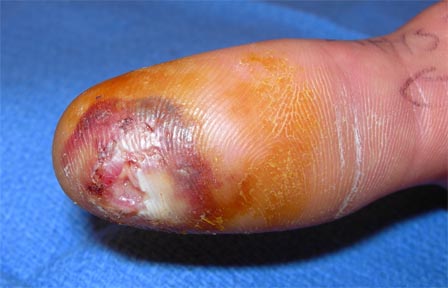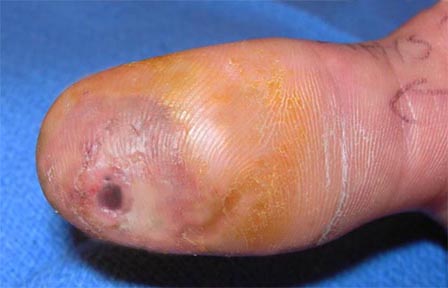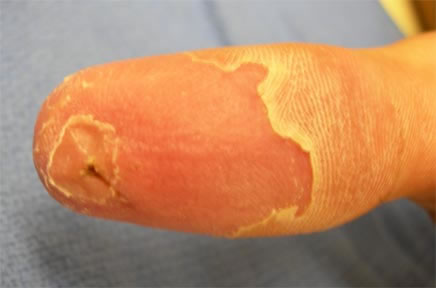Fingertip Infections
There are basically two types of fingertip infections: infections of the pulp (the soft, fatty part where your fingerprint is), called a felon; and infections of the area around the fingernail, called a paronychia. The unique anatomy of the fingertip determines the details of how these are treated.
Felon
A felon is an infection of the fingertip pulp that come in two forms: cellulitis, which is a non-pus forming infection, and an abscess (a cavity of pus). They usually start out as only slightly tender but can rapidly progress to extremely painful. These fingertip infections usually come from some type of penetrating injury, such as a small laceration (cut) or a splinter, but sometimes we cannot find any specific reason. The treatment depends on the form or stage of the infection. If the problem is only a cellulitis, hot soaks and oral (pills by mouth) antibiotics will do the trick, but close observation (office visits every other day or so) is needed. If the felon has progressed to the point of forming an abscess, surgical drainage is needed. The diagnosis of which stage the felon is in can be very difficult, because they both are red, swollen, and very painful, and the treatment is completely different for each stage. It is important to see a skilled hand surgery specialist. The prognosis is excellent if the infection is treated properly.
Hot Soaks
If the felon is still in the cellulitis stage, hot soaks and oral antibiotics are indicated. Hot soaks consist of putting the hand into very warm water: not hot enough to hurt, but hot enough to make the hand very red. The red means that there is a lot of increase blood flow to the hand, bringing the body's natural infection-fighting cells to the site as well as lots of antibiotics. The soaks should be about 20 minutes long, and often the hot water needs replacing. Additives such as epson salts are not needed, but some patients like to add it anyway. The hot soaks should be repeated five times a day.
Clinical Example of a Felon
The photograph below is the thumb of a young man who cut his thumb about two weeks prior on a piece of sheet metal around some blinds. He developed a felon, and tried to drain it with his pocket knife. It got worse and formed an abscess. He next saw several doctors who prescribed antibiotics. The problem is that antibiotics cannot treat an abscess, it needs to be opened up and drained. He was referred to me. The diagnosis was made of a felon that had progressed to the abscess stage. I also took an xray, and the bone was also infected (this is called osteomyelitis), with some of the bone eaten away. He was taken that day to the operating room, about two hours afterwards. I also called the infectious disease specialist to coordinate the antibiotic care.
 |
The abscess was actually smaller than it might have been. I released the pus, cleaned out the dead tissue, and cut off the dead callus. This is what was left: a small hole that went down to the bone. He was admitted to the hospital for IV antibiotics, and a special kind of IV was placed, called a PICC line, so he could get his treatment (6 weeks of IV antibiotics) at home. |
 |
The open wound was small, only about 4 mm, but it went all the way down to the bone. The pain resolved after surgery and the patient was sent home on IV antibiotics after a few dats. He was seen in the office 10 days later, with this appearance: |
 |
|
Paronychia
A paronychia is an infection around the edge of the fingernail. See my page on paronychias. Just like a felon, it can come in two types or stages: cellulitis, which is infection in the tissue but no pus, or an abscess, in which pus forms. These usually come from picking at the nail cuticle or just spontaneously from the normal bacteria on our skin. The cellulitis stage can be treated with hot soaks and antibiotics, with close followup (see the section on hot soaks, above). The abscess stage needs surgical drainage, which may be done in the office but might require a trip to the operating room. Sometimes it is difficult to tell which stage the paronychia is in, and since the treatments are completely different, it is important to see a good hand surgeon.
